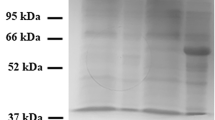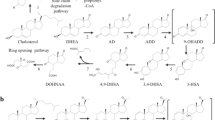Abstract
Homogeneous 3α-hydroxysteroid dehydrogenase (3α-HSD; EC 1.1.1.50) of rat liver cytosol is a monomeric (MR 34000) NAD(P)+ dependent oxidoreductase which displays 9-, 11- & 15-hydroxyprostaglandin dehydrogenase activity. The enzyme is potently inhibited by nonsteroidal anti-inflammatory drugs (NSAIDs), suggesting that 3α-HSD may be a target enzyme for NSAIDs. A monospecific, polyclonal anti-sera raised against the purified enzyme was used to screen a λgt11 expression library and oligonucleotide probes complementary to the 5′ and 3′ ends of immunopositive clones were used to isolate a 2.1 kb full-length cDNA. Digestion of the full-length cDNA with Eco RI generated two fragments of 1.1 and 1.0 kb in length. Both fragments were subcloned into pGEM3 and partially sequenced. The 1.1. kb fragment contains the C-terminus of 3α-HSD which was confirmed by an in-frame stop codon and comparison of the predicted amino acid sequence to peptide sequence obtained from two endo lys-C peptides of 3α-HSD. The 1.0 kb fragment is 5′ to the 1.1 kb fragment and is sufficient in length to contain the remainder of the entire open reading frame for 3α-HSD. Dideoxysequencing reveals significant sequence homology with bovine lung prostaglandin PGF2α synthase. These findings support the role 3α-HSD in inflammation and suggest that hydroxysteroid dehydrogenases, hydroxyprostaglandin dehydrogenases and prostaglandin F2α synthase may be members of a common gene family.
Similar content being viewed by others
References
T. M. Penning, I. Mukharji, S. Barrows and P. Talalay,Purification and properties of 3α-hydroxysteroid dehydrogenase of rat liver cytosol. Inhibition by anti-inflammatory drugs and prostaglandins. Biochem. J.222, 601–611 (1984).
T. M. Penning and R. B. Sharp,Prostaglandin dehydrogenase activity of purified rat liver 3α-hydroxysteroid dehydrogenase. Biochem. Biophys. Res. Comm.148, 646–652 (1987).
T. M. Penning and P. Talalay,Inhibition of a major NAD(P) +-linked oxidoreductase from rat liver cytosol by steroidal and nonsteroidal anti-inflammatory agents and by prostaglandins. Proc. Nat. Acad. Sci. USA.80, 4504–4508 (1983).
T. E. Smithgall and T. M. Penning,Indomethacin sensitive 3α-hydroxysteroid dehydrogenase in rat tissues. Biochem. Pharmacol.34, 831–835 (1985).
T. E. Smithgall and T. M. Penning,Electrophoretic and immunochemical characterization of 3α-hydroxysteroid/dihydrodiol dehydrogenases of rat tissues. Biochem. J.254, 715–721 (1988).
J. Sambrook, E. F. Fritsch and T. Maniatis,Molecular cloning: a laboratory manual. Second ed. Cold Spring Harbor Laboratory Press (1989).
F. Sanger, S. Nicklen and A. R. Coulson,DNA sequencing with chain-terminating inhibitors. Proc. Nat. Acad. Sci. USA.74, 5463–5467 (1977).
K. Isaacson, T. E. Smithgall, T. M. Penning and C. R. Lyttle,Cloning and regulation of 3α-hydroxysteroid/dihydrodiol dehydrogenase mRNA in rat liver. 70th Annual Meeting of the Endocrine Society, New Orleans, La, Abst. 1316 (1988).
K. Watanabe, Y. Fujii, K. Nakayama, H. Ohkubo, S. Kuramitsu, H. Kagamiyama S. Nakanishi and O. Hayaishi,Structural similarity of bovine lung prostaglandin F synthase to lens ɛ-crystallin of the European common frog. Proc. Natl. Acad. Sci. USA85, 11–15 (1988).
Author information
Authors and Affiliations
Rights and permissions
About this article
Cite this article
Pawlowski, J., Huizinga, M. & Penning, T.M. Isolation and partial characterization of a full-length cDNA clone for 3α-hydroxysteroid dehydrogenase: A potential target enzyme for nonsteroidal anti-inflammatory drugs. Agents and Actions 34, 289–293 (1991). https://doi.org/10.1007/BF01993305
Issue Date:
DOI: https://doi.org/10.1007/BF01993305




